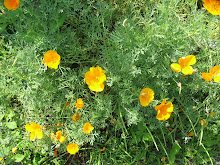
"Like an/Autumn flower/In the frozen rain," Langston Hughes described an old woman in the poem "Troubled Woman." I think the flower he referring to was a late-season zinnia, one of the fall's last signs of color. Sure, they are not alone at this point--some nasturtiums, marigolds, and phlox are also floral holdouts, but I visualize the zinnia because of the way it ages so gracefully, the color of the blooms still faded but beautiful. Their stems stand with dignity until it's time to give in the the fall chill.
I've been planting zinnias since I was a child, probably for the same reasons all along: they're easy to grow and almost always a success (except for the one year I planted old seeds). A few seeds in May, a little water and full sun and by late July you have a colorful reward. Although I've leaned more toward perennials in recent years, I still can't give up that 3 by 4 foot patch. During the peak of their blooming season, a bouquet can last for a week. Zinnias are still there for me after I've deadheaded and cut down every other flower around them; they stand guard and distract the eye from the tangle of vegetable plants that I know I need to clear out, soon.
First believed to have been cultivated in Austria in 1613, zinnias have been selectively bred since the 19th century. The annual plant as we know it has its origins in the southwestern US, Mexico, and Central America, so their love of sun should come as no surprise. I find them growing in about at least a dozen of the 40+ plots at the Minton Stable Garden. They might look a little garish next to native perennials, but in a plot of mostly vegetables they add a colorful contrast.


1 comment:
I've been thinking about zinnias all Fall. I'm definitely more of a perennial (read lazy) gardener. But I do love zinnias and I have planted them in a few years. The Fall is definitely missing something. Next year, I'm definitely sow some zinnia seeds....
Post a Comment